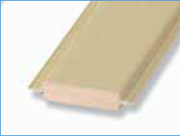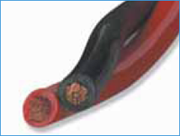
Conductors
Conductor material selection is critical in meeting electrical performance and mechanical rigidity requirements. Common materials used are copper, aluminum, and a variety of copper alloys. The material chosen, the mechanical constraints and the electrical performance for the specific application determine the conductor’s minimum mechanical dimensions (see Conductor Size in the Electrical Design section).
Thermal considerations may require system ventilation to remove excess heat from the bus bar. In this case, bus bar configuration might be low in profile, thereby changing the orientation of the bus structure and the airflow. Bus bars may also serve to remove heat from components by performing as a heat sink.
The selection of tabs or terminations may determine conductor thickness if there’s a need to accept studs, nuts, tabs or threaded inserts. Minimum mechanical requirements for the connection style chosen must be considered for overall efficiency and cost effectiveness.
Grounds
he ground return conductor should be equal in size and circular mil area to its corresponding voltage conductor. A few advantages of a separate ground return are:
- double the effective capacitance;
- greater area for cooling, to minimize the voltage drop due to temperature rise;
- drastically reduced intercoupling effects and
- the opportunity for advantageous shielding between levels, obtained by the use of interleaved grounds.
Mounting
To mount a bus bar to an assembly structure, hardware (studs, holes, etc.) can be manufactured into the conductors. An alternative ground plane may be added as support for the bus bar assembly and to provide a platform for mounting hardware.
Finish
Mersen offers in-house conductor plating in tin, tin-lead, nickel, silver, or gold. Plating is a major consideration in designing a bus bar because it is the point of contact for all bus bar electrical connections. The plating can provide advantageous electrical properties, decreasing the voltage drop. When gold is used, it is generally only plated on termination surfaces to minimize cost.
Insulation
Bus bars use many different types of adhesive-coated insulation materials to permit structure layers to be laminated together. There are added benefits from an electrical perspective. Insulation provides an inside and outside barrier to its installed environment. Insulations can increase the capacitance and lower the inductance and impedance. Commonly used insulation materials are: Nomex®, Tedlar®, Mylar®, Kapton®, Ultem®, Mylar/Tedlar, Tedlar/Mylar/Tedlar, Valox®, epoxy-glass, heat shrink tubing, and epoxy powder coating. There are many different thicknesses of these insulation materials available. Contact a Mersen engineer for more information. Special insulations are available upon request.
Cost considerations
Prices of bus bar assemblies vary depending upon quantity ordered. In addition, individual dimensional characteristics, materials, manufacturing techniques, the interconnection scheme, plating finish, insulation, and hardware requirements affect overall cost.
Mersen engineers are available to assist in developing the most efficient and cost-effective design to provide solutions to any power distribution problem. The earlier we are involved in your design process, the more cost-effective your solution is likely to be. Early involvement enables us to optimize both ease of manufacturing and turnaround time. We recommend that you contact a new-product development engineer before you start designing your laminated bus bar power distribution system.
Electrical design
Important characteristics of laminated bus bars are resistance, series inductance, and capacitance. As performance parameters of electronic equipment and components become more stringent, these characteristics take on even more importance. In determining the impedance of a power distribution system, these characteristics are significant in solving two of the most important problems for designers – resistance and noise. It is important, therefore, to understand the electrical characteristics of the laminated bus bar.
Figure 1 shows a basic two-conductor laminated bus bar and Figure 2 shows its equivalent circuit. The bus bar is composed of two parallel conducting plates separated by a dielectric. The equivalent circuit illustrates the associated inductance (L), capacitance (C), and resistance (R), which are most often uniformly distributed along the bus bar. We discuss the basic relationships between physical dimensions and electrical parameters in the following analysis.

Figure 1.
Physical Representation

Figure 2.
Electrical Equivalent

